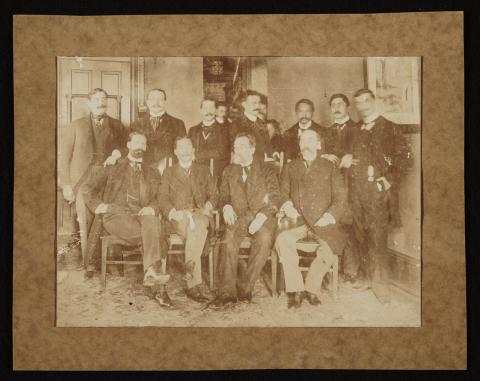
Commissioners from Cuba, the Philippines, and Puerto Rico in Washington, D.C.
Representatives from Spain and the United States signed the Treaty of Paris on December 10, 1898, ending the War of 1898. The people whose futures were at stake were not present in the negotiations. However, before the Senate ratified the Treaty on February 6, 1899, commissioners from Cuba, the Philippines, and Puerto Rico traveled to Washington, D.C., to demand participation in the process. While newspapers documented these events, their visit is seldom referenced in historical accounts.
This group portrait documents their visit to the capital. Seated from left to right are Ramón Villalón Sánchez (1864–1938), from Cuba; Felipe Agoncillo (1859–1941), from the Philippines; and Eugenio María de Hostos (1839–1903) and José Julio Henna (1848–1924), both from Puerto Rico. Standing in the back, third from the right, is the Filipino artist Juan Luna (1857–1899). Despite their combined effort to inform crucial decisions, the U.S. government ignored them.
Audio Transcription: One of the first tasks in organizing this exhibition was finding the primary sources, the letters, the photographs, the pamphlets to tell the history of the conflicts of 1898 and its immediate aftermath. And so I came across this photograph during a visit to the Library of Congress and I was sitting within the reading room and I remember gasping when I opened the folder. Immediately I recognized Eugenio María de Hostos from Puerto Rico and Felipe Agoncillo from the Philippines sitting in the front row. I knew that they had made visits to Washington D.C. around this time, to try to negotiate the conditions of the Treaty of Paris before it was ratified, but I had no idea that they were in the same room. This photograph also raised questions. It reminded me of Theobald Chartran's large-scale painting, which hangs in the Treaty Room of the White House. In that painting representatives from the United States and from Spain, together with President McKinley, sign the agreement that would end the war and determine the political futures of the former Spanish colonies. However, none of the representatives of the former Spanish colonies, which we see in this photograph, are depicted in that painting. I think this photograph is very important. It asks us the question: Who is written into history and who is not? Who is depicted in a large-scale oil painting in pristine conditions visible to visitors to the White House, and whose portraits are closed off-- small, flimsy, undigitized-- within the files and folders of an archive?
– My name is Carolina Maestre and I'm the curatorial assistant of Latino art and history, and for "1898: U.S. Imperial Visions and Revisions."